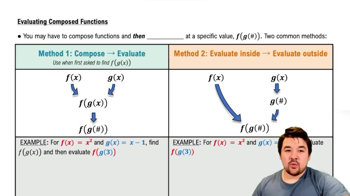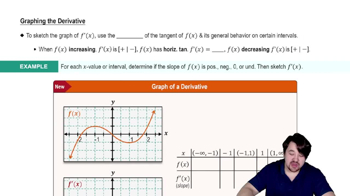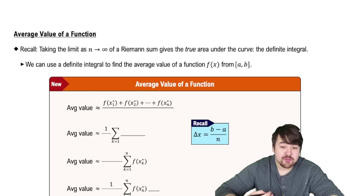Consider the position function s(t) =−16t^2+100t representing the position of an object moving vertically along a line. Sketch a graph of s with the secant line passing through (0.5, s(0.5)) and (2, s(2)). Determine the slope of the secant line and explain its relationship to the moving object.
Table of contents
- 0. Functions7h 54m
- Introduction to Functions16m
- Piecewise Functions10m
- Properties of Functions9m
- Common Functions1h 8m
- Transformations5m
- Combining Functions27m
- Exponent rules32m
- Exponential Functions28m
- Logarithmic Functions24m
- Properties of Logarithms36m
- Exponential & Logarithmic Equations35m
- Introduction to Trigonometric Functions38m
- Graphs of Trigonometric Functions44m
- Trigonometric Identities47m
- Inverse Trigonometric Functions48m
- 1. Limits and Continuity2h 2m
- 2. Intro to Derivatives1h 33m
- 3. Techniques of Differentiation3h 18m
- 4. Applications of Derivatives2h 38m
- 5. Graphical Applications of Derivatives6h 2m
- 6. Derivatives of Inverse, Exponential, & Logarithmic Functions2h 37m
- 7. Antiderivatives & Indefinite Integrals1h 26m
- 8. Definite Integrals4h 44m
- 9. Graphical Applications of Integrals2h 27m
- 10. Physics Applications of Integrals 3h 16m
- 11. Integrals of Inverse, Exponential, & Logarithmic Functions2h 31m
- 12. Techniques of Integration7h 41m
- 13. Intro to Differential Equations2h 55m
- 14. Sequences & Series5h 36m
- 15. Power Series2h 19m
- 16. Parametric Equations & Polar Coordinates7h 58m
1. Limits and Continuity
Introduction to Limits
Problem 3c
Textbook Question
Use the graph of h in the figure to find the following values or state that they do not exist. <IMAGE>
h(4)
 Verified step by step guidance
Verified step by step guidance1
Examine the graph of the function \( h(x) \) provided in the image to locate the point where \( x = 4 \).
Identify the corresponding \( y \)-value on the graph at \( x = 4 \). This \( y \)-value is \( h(4) \).
Check if the graph has a defined point at \( x = 4 \). If there is a point, note its \( y \)-coordinate.
If the graph has a hole or discontinuity at \( x = 4 \), then \( h(4) \) does not exist.
Conclude by stating the value of \( h(4) \) if it exists, or confirm that it does not exist based on the graph's behavior at \( x = 4 \).
 Verified video answer for a similar problem:
Verified video answer for a similar problem:This video solution was recommended by our tutors as helpful for the problem above
Video duration:
1mPlay a video:
Was this helpful?
Key Concepts
Here are the essential concepts you must grasp in order to answer the question correctly.
Function Evaluation
Function evaluation involves determining the output of a function for a specific input value. In this case, evaluating h(4) means finding the value of the function h when the input is 4. This process typically requires substituting the input into the function's formula or using a graph to identify the corresponding output.
Recommended video:

Evaluating Composed Functions
Graph Interpretation
Graph interpretation is the ability to read and analyze graphical representations of functions. It involves understanding the axes, identifying points on the graph, and determining the behavior of the function at specific values. For this question, one must look at the graph of h to find the value of h(4) visually.
Recommended video:

Graphing The Derivative
Existence of Function Values
The existence of function values refers to whether a function produces a valid output for a given input. In some cases, a function may not be defined at certain points, leading to the conclusion that a value does not exist. In this question, if the graph does not show a point at x=4, it indicates that h(4) does not exist.
Recommended video:

Average Value of a Function

 6:47m
6:47mWatch next
Master Finding Limits Numerically and Graphically with a bite sized video explanation from Patrick
Start learningRelated Videos
Related Practice
Textbook Question
